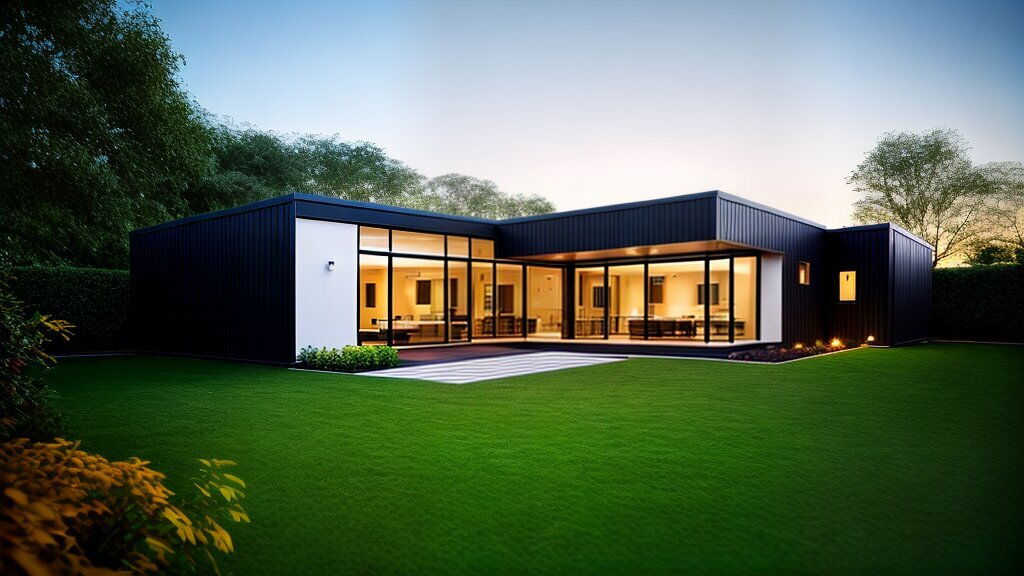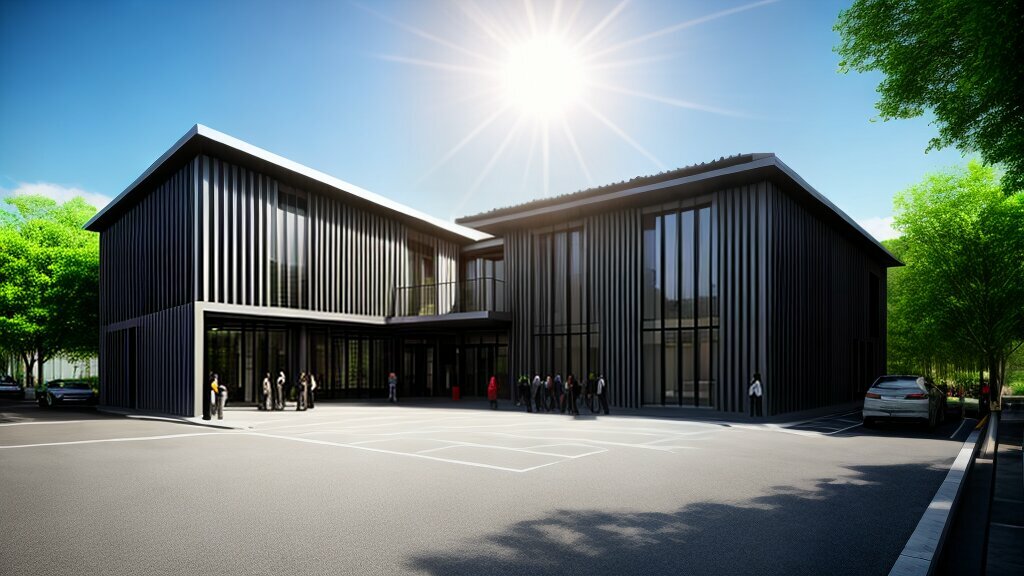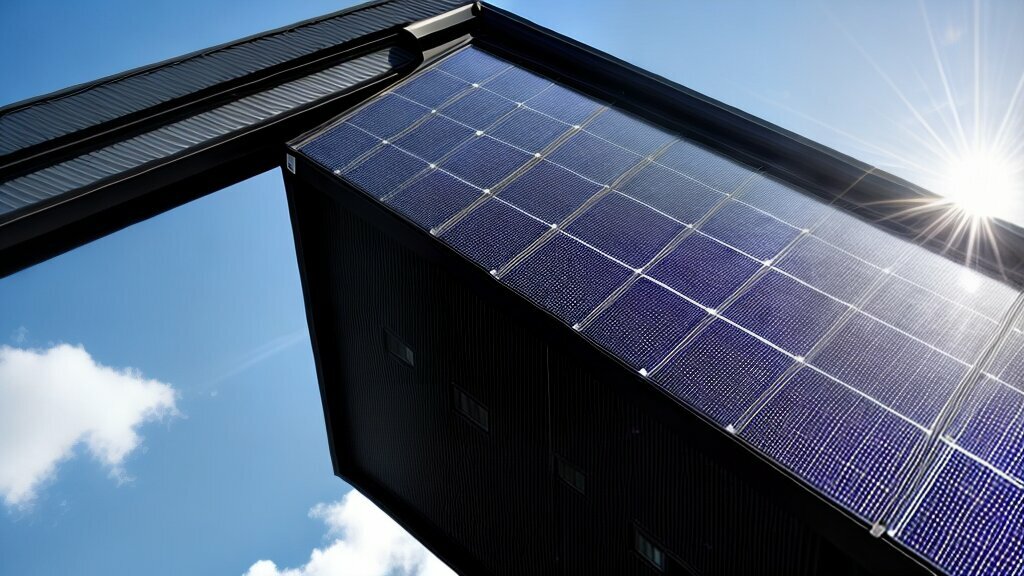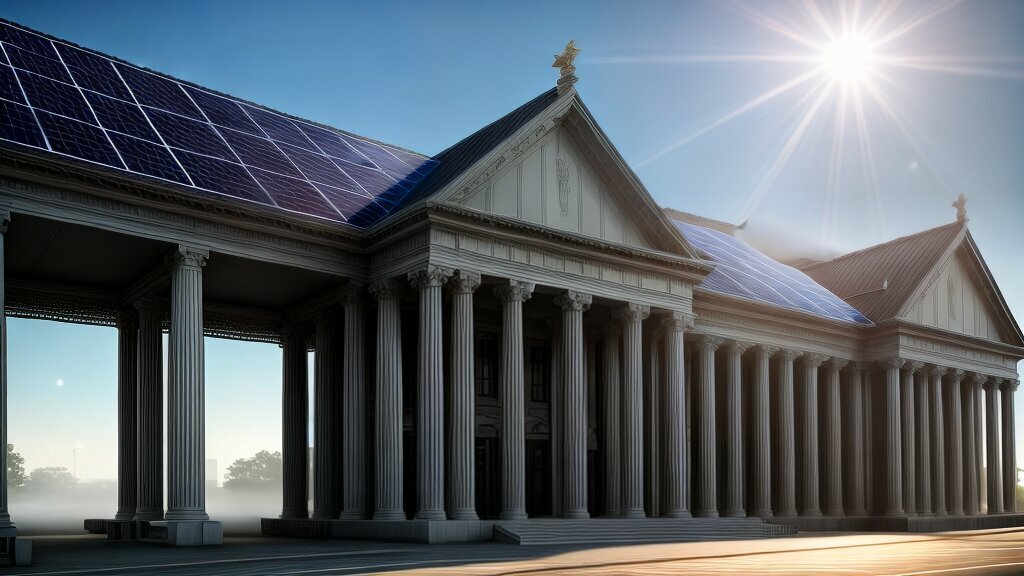Welcome to this article on the latest advancements in solar integration for sustainable building energy systems. As the world increasingly recognises the urgent need to address climate change and reduce carbon emissions, the importance of renewable energy and green building for energy-efficient design has never been greater. In this article, we will explore the benefits, challenges, and emerging trends related to solar integration in sustainable building practices.
Key Takeaways:
- Solar integration is essential for sustainable building practices.
- Renewable energy and green building are crucial for energy-efficient design.
Sustainable architecture has become increasingly important in recent years, with a focus on reducing the environmental impact of buildings while enhancing their functionality and aesthetic appeal. One of the key components of sustainable building practices is the incorporation of renewable energy sources, particularly solar power, into building design and construction. This section will discuss the benefits of solar integration in sustainable building and its potential to create net-zero energy buildings.
The Advantages of Incorporating Solar Power in Construction
The use of solar power in construction has numerous benefits, including reduced energy consumption and cost savings on utility bills. By using solar panels to generate electricity, a building can drastically reduce its dependence on traditional power sources, resulting in significant cost savings over time. Additionally, solar power is a clean and renewable energy source, making it a sustainable choice for environmentally conscious building projects.
Potential for Net-Zero Energy Buildings
Solar integration in sustainable building also has the potential to create net-zero energy buildings, which generate as much energy as they consume. This is achieved through a combination of energy-efficient design and the use of renewable energy sources, such as solar power. Net-zero energy buildings are not only environmentally friendly but also offer long-term cost savings, as they can eliminate or greatly reduce utility bills.
Benefits for Sustainable Building Practices
Integrating solar power into sustainable building practices can also contribute to wider sustainability goals, such as reducing carbon emissions and promoting energy-efficient design. By reducing a building’s reliance on traditional energy sources, solar integration can play a significant role in combatting climate change and promoting a greener future.
Overall, incorporating solar integration into sustainable building practices offers numerous benefits, including cost savings, environmental sustainability, and the potential for net-zero energy buildings.

Solar Integration Technologies in Sustainable Building
When it comes to incorporating solar integration in sustainable building, there are a variety of technologies available. One of the most common methods is through the use of solar photovoltaic (PV) systems. These systems convert sunlight into electricity, providing a renewable energy source for the building.
Solar PV systems can be installed on rooftops, facades, or even integrated into building materials like glass. The electricity generated by these systems can be used to power the building’s lighting, heating, and cooling systems, reducing reliance on fossil fuel-based energy sources.
Another important aspect of solar integration in sustainable building is the use of green building materials. These materials are selected for their minimal impact on the environment, both in terms of production and disposal. Examples of green building materials include sustainably harvested wood, recycled steel and concrete, and bamboo.
When it comes to designing a solar integration system for a sustainable building, it’s important to consider both the energy efficiency of the system and the overall sustainability of the design. This can involve making decisions about the orientation of the building, the positioning of solar panels, and the selection of green building materials.

“Solar PV systems can be installed on rooftops, facades, or even integrated into building materials like glass.”
Overall, the use of solar integration technologies and green building materials can help to create more sustainable and energy-efficient buildings. As these technologies continue to advance, we can expect to see even more innovation and creativity in the field of sustainable architecture.
Designing Solar Integration Systems for Sustainable Buildings
When designing solar integration systems for sustainable buildings, it is crucial to consider energy efficiency and sustainable design principles. Here are some best practices to keep in mind:
- Site orientation and shading: The orientation and placement of the building on the site can have a significant impact on the amount of solar energy that can be captured. Make sure to take into account shading from trees, nearby buildings, and other objects that can block the sun’s rays.
- Solar photovoltaic (PV) systems: Solar PV systems are a popular choice for sustainable buildings because they generate electricity without emitting greenhouse gases. When designing a solar PV system, consider factors such as the size and orientation of the solar panels, the type of inverter used, and the wiring system.
- Green building materials: In addition to solar PV systems, incorporating green building materials can further enhance the energy efficiency of a sustainable building. Materials such as insulated concrete forms, triple-glazed windows, and energy-efficient lighting can help reduce energy consumption and costs.
- Energy storage: To ensure a steady supply of solar energy, consider incorporating energy storage systems such as batteries or thermal storage systems. These can help reduce reliance on the grid and provide backup power during outages.
- Monitoring and maintenance: Proper monitoring and maintenance of a solar integration system is essential to ensure optimal performance and longevity. Regular inspections, cleaning, and repairs can help prevent problems and keep the system running smoothly.
By following these best practices and considering energy efficiency and sustainable design principles, architects and builders can create solar integration systems that are both effective and environmentally friendly.

Overcoming Challenges in Solar Integration for Sustainable Building
While incorporating solar integration in sustainable building practices is essential for reducing carbon emissions and achieving energy efficiency, there are several challenges and barriers that must be overcome, such as:
- Initial costs: The upfront costs of installing solar systems can be high, which can deter builders and property owners from pursuing solar integration. However, it’s important to remember that solar integration offers long-term cost savings and can improve property values.
- Integration with existing infrastructure: Retrofitting existing buildings with solar systems can be challenging, especially if the building’s infrastructure is not designed to support such integration. This can require significant modifications and upgrades to the building’s electrical and mechanical systems.
- Limited availability of green building materials: Solar integration requires the use of green building materials that are sustainably sourced, energy-efficient, and durable. However, the availability of such materials can be limited, which can make it difficult to incorporate solar integration into sustainable building practices.
Despite these challenges, it’s important to continue pushing for solar integration in sustainable building practices and finding ways to overcome these barriers. By doing so, we can achieve a more sustainable and energy-efficient future for all.

Case Studies on Successful Solar Integration in Sustainable Building
Real-life examples of successful solar integration in sustainable building projects demonstrate the potential for energy-efficient design practices to achieve net-zero energy goals. Let’s take a closer look at some of these case studies:
1. The Edge, Amsterdam
Completed in 2014, The Edge in Amsterdam is known as one of the greenest office buildings in the world. It features a massive rooftop solar array that produces more energy than the building consumes, making it a net-positive building. The Edge incorporates a range of smart building technologies, including an app that allows employees to control their workspace environment and monitor energy usage.

2. Phipps Conservatory and Botanical Gardens, Pittsburgh
The Phipps Conservatory and Botanical Gardens in Pittsburgh is a green building that features a range of sustainable design features, including solar panels and a geothermal heating and cooling system. The building’s Center for Sustainable Landscapes was the first in the world to achieve the Living Building Challenge, a rigorous sustainability certification that requires net-zero energy usage and the use of non-toxic, locally sourced materials.
3. Bullitt Center, Seattle
The Bullitt Center in Seattle is a six-story, 50,000 square foot building that is designed to be net-zero energy and carbon neutral. It features a 244-kilowatt solar panel array on the roof and a rainwater harvesting system that provides all of the building’s non-potable water needs. The Bullitt Center is also built almost entirely out of locally sourced, non-toxic materials.
These case studies highlight the numerous benefits of solar integration in sustainable building, including energy efficiency, cost savings, and a smaller environmental footprint. As more and more buildings adopt sustainable design practices, we can look forward to a future that is powered by renewable energy and built with the environment in mind.
Future Trends in Solar Integration for Sustainable Building
The future of solar integration in sustainable building looks promising, with continued advancements in technology and increasing awareness of the importance of creating energy-efficient and environmentally friendly buildings. One emerging trend is the integration of solar panels with smart building systems, allowing for greater control and optimization of energy usage. This can lead to even greater energy savings and cost reduction.
Another exciting development is the potential for entire communities to be powered by solar energy. The concept of solar-powered neighborhoods is gaining traction, with some areas already implementing this innovative approach to sustainable living. This not only reduces our dependence on non-renewable energy sources but also creates a sense of community and shared commitment to environmental responsibility.
Advancements in solar technology also offer exciting possibilities for sustainable building. Researchers are working on developing solar tiles that blend seamlessly into traditional roofing materials, providing a sleek and stylish option for solar integration in residential and commercial buildings.
Finally, the use of green building materials is becoming increasingly popular, with many developers and architects prioritizing environmentally friendly and sustainable options in their designs. This includes the use of materials such as bamboo, recycled plastic, and reclaimed wood to create buildings that are not only energy-efficient but also aesthetically pleasing and environmentally responsible.
Overall, the future of solar integration in sustainable building looks bright, with innovative solutions and a growing commitment to environmentally responsible practices driving the industry forward.

Government Initiatives and Incentives for Solar Integration
The adoption of solar integration in building construction and design has been incentivized by the government through tax credits, grants, and regulations. The incentives encourage energy-efficient design and the use of renewable energy sources to reduce carbon emissions.
One such program is the Solar Investment Tax Credit (ITC), a federal tax credit that provides a 26% credit for the total cost of installing a solar energy system on a residential or commercial property. This credit has been extended until 2022. Additionally, some states and local municipalities offer their own tax credits, rebates, and incentives for solar integration in sustainable building.
| Government Incentives |
Description |
| Green Building Certification Programs |
The government has established programs such as the Leadership in Energy and Environmental Design (LEED) certification to encourage green building practices and offer tax credits to buildings that comply. |
| Grants |
The government provides grants to fund the research and development of solar integration technologies, which can be used to further improve energy efficiency and reduce carbon emissions in building design and construction. |
| Net-Zero Energy Building Regulations |
Some states have established regulations that require new constructions to be designed as net-zero buildings, meaning they are capable of generating as much energy as they consume. This encourages the use of solar integration and other renewable energy sources. |
The government’s commitment to sustainability and the reduction of carbon emissions has been vital in promoting solar integration in sustainable building practices. These initiatives and incentives are encouraging architects, builders, and property owners to adopt renewable energy and energy-efficient design principles, resulting in a greener and more sustainable future.

The Role of Solar Integration in Achieving Sustainable Development Goals
As the world’s population continues to grow, so does the demand for energy. However, with climate change and its devastating impact on the planet, the focus has shifted towards finding sustainable and renewable energy sources. This is where solar integration in sustainable building practices plays a vital role in achieving sustainable development goals.
The United Nations’ Sustainable Development Goals (SDGs) aim to address the world’s most pressing environmental, social, and economic challenges. Among these goals, the seventh SDG focuses on ensuring access to affordable, reliable, sustainable, and modern energy for all. This goal aligns perfectly with the use of solar integration in sustainable building practices.
By incorporating solar photovoltaic systems and other solar integration technologies into building design, energy efficiency is improved, helping reduce carbon emissions, and supporting the transition to a cleaner energy future. Solar integration systems also offer the potential for net-zero energy buildings, where a building’s total energy consumption is offset by renewable energy generated on-site. This contributes significantly to achieving the SDG of affordable and clean energy.
Furthermore, solar integration in sustainable building practices also aligns with other sustainable development goals, such as combating climate change and reducing carbon emissions. By reducing reliance on non-renewable energy sources, we can limit the negative impact on the environment, fostering sustainable communities, and supporting the well-being of current and future generations.
As we continue to move towards a greener and more sustainable future, solar integration in sustainable building practices will play an increasingly critical role in achieving sustainable development goals. It’s crucial that governments, businesses, and individuals work together to promote and adopt these practices, contributing to a cleaner, healthier, and more sustainable planet.

Conclusion
Solar integration in sustainable building practices is crucial for a greener and more energy-efficient future. The benefits of incorporating solar power in construction are evident, with reduced energy consumption, cost savings, and the potential for net-zero energy buildings.
By exploring different solar integration technologies, such as solar photovoltaic systems and green building materials, and designing systems with energy efficiency and sustainable design principles in mind, we can overcome the challenges associated with solar integration in sustainable building.
Real-life examples of successful solar integration in sustainable building projects demonstrate the potential for achieving energy efficiency, cost savings, and net-zero energy goals. As emerging trends and innovations in solar integration for sustainable building continue to evolve, we can look forward to advancements in solar technology, integration with smart building systems, and even solar-powered communities.
With government initiatives and incentives aimed at promoting solar integration in sustainable building, such as tax credits, grants, and regulations requiring renewable energy usage in new construction, it is clear that solar integration plays a crucial role in achieving sustainable development goals.
Ultimately, as we strive towards a more sustainable future, solar integration in sustainable building practices will continue to be a key factor in achieving a greener and more energy-efficient world.
FAQ
Q: What is solar integration in sustainable building?
A: Solar integration in sustainable building refers to the incorporation of solar technology and systems in the design, construction, and operation of buildings to harness renewable energy and reduce reliance on traditional energy sources.
Q: What are the benefits of solar integration in sustainable building?
A: Solar integration in sustainable building brings various advantages, including reduced energy consumption, cost savings on electricity bills, and the potential for net-zero energy buildings that generate as much energy as they consume.
Q: What are the solar integration technologies used in sustainable building?
A: The main solar integration technologies used in sustainable building include solar photovoltaic systems that convert sunlight into electricity and the use of green building materials that maximize solar energy utilization.
Q: How should solar integration systems be designed for sustainable buildings?
A: Designing solar integration systems for sustainable buildings requires considerations such as energy-efficient design principles, optimal placement of solar panels, and integration with the building’s overall architecture and energy systems.
Q: What challenges are associated with solar integration in sustainable building?
A: Some challenges in solar integration for sustainable building include the initial costs of installing solar systems, integration with existing infrastructure, and the availability of suitable green building materials.
Q: Can you provide examples of successful solar integration in sustainable building projects?
A: Yes, there are numerous case studies showcasing successful solar integration in sustainable building projects. These projects demonstrate improved energy efficiency, cost savings, and contribute to achieving net-zero energy goals.
Q: What are the future trends in solar integration for sustainable building?
A: Emerging trends include advancements in solar technology, integration with smart building systems, and the potential for solar-powered communities that generate and share renewable energy.
Q: Are there any government initiatives and incentives for solar integration in sustainable building?
A: Yes, many governments provide incentives such as tax credits, grants, and regulations that promote the adoption of solar integration in sustainable building, aiming to support sustainable architecture and the use of green building materials.
Q: How does solar integration contribute to achieving sustainable development goals?
A: Solar integration aligns with sustainable development goals by combating climate change, reducing carbon emissions, and ensuring affordable and clean energy access. It plays a vital role in promoting sustainable building practices and energy-efficient design.
You may also like – Net-Zero Energy Buildings: Design Principles and Case Studies
and Community-Driven Sustainable Construction: Empowering Local Initiatives


























Post comments (2)